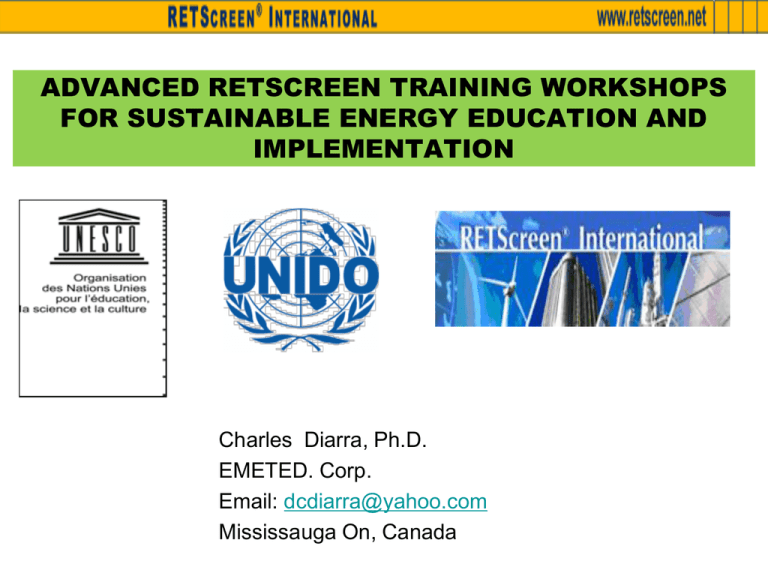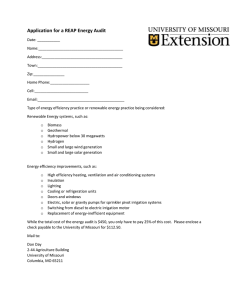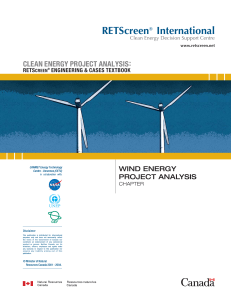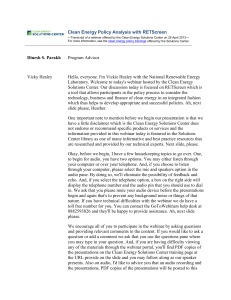Advanced Retscreen Training Workshops for Sustainable Energy
advertisement

ADVANCED RETSCREEN TRAINING WORKSHOPS FOR SUSTAINABLE ENERGY EDUCATION AND IMPLEMENTATION Charles Diarra, Ph.D. EMETED. Corp. Email: dcdiarra@yahoo.com Mississauga On, Canada Introduction Recognizing that the supply of a skilled workforce is a critical element in the transfer of technology and due to the enormous needs for institutional and human resource development, UNESCO launched Renewable Energy Education and Training Program as an instrument to help the international community address this issue To help rural communities to remove barriers to the diffusion, distribution, and development of renewable energy technologies. Promote Capacity building, training and education Enhance Energy efficiency programs THE Context • About 1.4 billion people do not have access to grid connected electricity. • The potential of renewable energy is generally greater than the demand in most countries around the world, particularly in developing countries • The intergovernmental Panel of Experts (Abou Dhabi, UAE, 2011), indicated that less than 2.5% of the available renewable energy technologies are exploited in the world OBJECTIVES Promote institutional and human capacity building to reflect the needs for education for professionals at different levels of responsibility Strengthen national competencies by favoring exchange of knowledge and best practices; Enhancing the use and application of renewable Participants learning to use sizing software to energy sources. determine the exact energy needed for a given project, during a one-day practical Develop a network of session at this year’s solar school train-the trainers Main activities Organization of training programs at different levels, including: • Continuing training for professionals: (decision and policy makers, researchers, engineers, university teachers, technicians) Design and field implementation of training tools and learning-teaching materials; Promotion of national/regional training Practical training to assess solar radiation and simulate a solar installation. This session centres of excellence at the regional level was organized at the CDER in • Setting of standards and definition of energy Morocco during the 2001 summer school http://portal.unesco.org/scienc • training curricula e/en/files/4137/10980872981S olar_School Participants learning to use sizing software to determine the exact energy needed for a given project, during a one-day practical session at this year’s solar school 2. RETSCREEN SOFTWARE RETScreen Clean Energy Project Analysis Software is a unique decision support tool Developed with the contribution of numerous experts from government, industry, and academia. The software can be used worldwide to evaluate the energy production and savings, costs, emission reductions, financial viability and risk for various types of Renewableenergy and Energy-efficient Technologies. The software (available in multiple languages) also includes product, project, hydrology and climate databases A detailed user manual, and a case study based college/university-level training course 2.1 OBJECTIVES OF THE TRAINING The overall objective of the RET Screen workshop is to build up a regional train-the-trainers network on RE&EE project appraisal in the region. The RETScreen evaluation tool will be one tool apart of others being applied by the network (e.g. HOMER etc.) The specific objective of the workshop is to provide training on financial RE&EE project analysis by applying the RETScreen Software Tool To ensure high-quality training and follow-up support for the participants. 2.2 Beneficiaries • Direct beneficiaries and participants of the workshops are RE&EE training institutes from all ECOWAS countries, the National Focal Institutions NFIs), staff and private sector experts. • The training include a certification exam in the use of RETScreen. 2.3 DEFINITION Energy Efficiency • Using less energy resources to meet the same energy needs Clean Energy Technologies Renewable Energy • Using non-depleting natural resources to meet energy needs How much do these studies typically cost? Super Insulated Passive Solar Home Photo : Jerry Shaw © Ministre de Ressources naturelles Canada 2001 – 2004.






